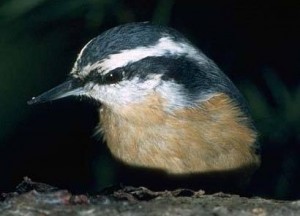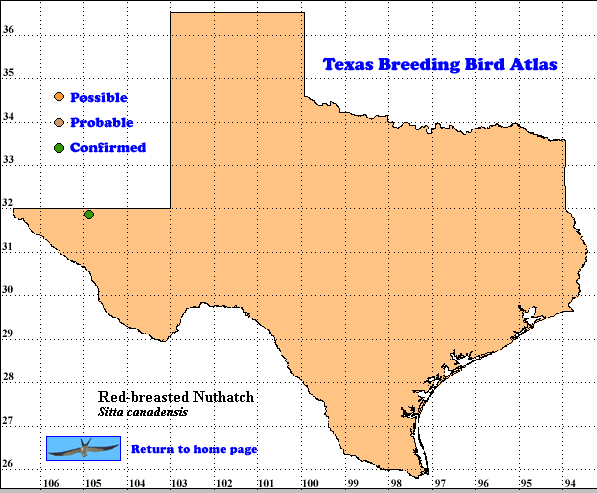The unmistakable yank-yank call of the Red- breasted Nuthatch is a characteristic sound of the coniferous forests where this small bird forage for invertebrates on the bark of trees, moving up, down or sideways. The species resides in forests with at least some spruce, true fir or Douglas fir while other nuthatches of North America prefer either pure pine (Pygmy [Sitta pygmaea)] and Brown-headed [S. pusilla]) nuthatches) or deciduous woodlands (White-breasted Nuthatch [S. carolinensis]). Texas is indeed fortunate to have all of these nuthatches as members of its avifauna.
DISTRIBUTION. During the 1987-1992 field work for the TBBA project, observers found confirmed breeding evidence for Red-breasted Nuthatch in the Guadalupe Mountains of Trans Pecos Texas where Lockwood and Freeman (2004) reported nesting in 1994 and 2002. Oberholser (1974) did not report any nesting records. Access to upper elevations of the Guadalupes is not easy, hence breeding may be more regular than these dates indicate.
Elsewhere Red-breasted Nuthatches are resident from the south coast of Alaska across Canada and the northern and eastern Great Lakes states to Labrador, Newfoundland, New England and the Appalachian Mountains. In the western United States, the species is resident from Washington, Idaho and western Montana through the thick coniferous habitats of the Cascades, Sierras, Rockies and California coast and desert ranges to the Mexican border (Ghalambor and Martin 1999).
SEASONAL OCCURRENCE. Lockwood and Freeman (2004) indicate Red-breasted Nuthatch is an irruptive species in Texas, Fairly common through most of the state in some winters and almost absent in others. Extreme dates for winter visitors are August 20 and May 4 with the bulk of visitors in irruptive years present from mid-October to mid-April (Oberholser 1974). In Colorado where much more montane habitat is available, confirmed breeding evidence was found from May 14 to August 21 (Barrett 1998) and in Arizona from May 1 to July 20 (Spence 2005).
BREEDING HABITAT. In Arizona, where montane habitats have similarities to those in the Guadalupes, about 83% of breeding records came from habitats dominated by ponderosa pine and mixtures of pine, Douglas fir, spruces and true firs (Spence 2005). In Colorado 82% of confirmed breeding evidence was found in coniferous forests and woodlands (Barrett 1998). Pairs of Red-breasted Nuthatches typically nest in a cavity that they excavate in soft dead or rotten wood. Often the male starts the process while attracting a mate who then finishes the hole while he feeds her and guards the site. Cavities average 4 cm (1.5 in deep and wide and height 1.3 cm (0.5 in) but dimensions are quite variable probably depending on softness of wood. The cavity is lined with grasses, bark shreds and pine needles and the cup is lined with softer materials including animal hair and feathers. A unique feature is the application of sticky conifer resin around the entrance hole (Harrison 1979, Ghalambor and Martin 1999).
The mean clutch size is 6 (range 5-8) smooth, creamy or pinkish white eggs (see Harrison [1979] for photo of markings). The female incubates the eggs for 12-13 days and young birds leave the nest 18-21 days after hatching. Pairs raise one successful brood per year and brood parasitism is very rare (Ghalambor and Martin 1999).
STATUS. There are only a few records of breeding of this nuthatch in Texas, all in the Guadalupe Mountains (Oberholser 1974, Lockwood and Freeman 2004). The North American Breeding Bird Survey does not sample this species in this state.Data from 1119 routes (40 km [25 mi]) in the United States and Canada provide a statistically significant trend of +1.5% population change per year for the period 1966-2004 (Sauer et al. 2005). Red-breasted Nuthatches will continue to breed rarely in the Guadalupe Mountains as long as a conifer forest exists there and irrupt in the winter throughout the state at irregular intervals.
Text by Robert C. Tweit (2006)
Literature cited.
Barrett, N. A. 1998. Red-breasted Nuthatch (Sitta canadensis). In Colorado breeding bird atlas, pp. 356-357 (H. E. Kingery, ed.). Colorado Bird Atlas Partnership, Denver.
Ghalambor, C. K. and T. E. Martin. 1999. Red-breasted Nuthatch (Sitta canadensis). In The birds of North America, No. 459 (A. Poole and F. Gill, eds.). The Birds of North America, Inc., Philadelphia, PA.
Harrison, H. H. 1979. A field guide to western birds’ nests. Houghton Mifflin, Boston, MA.
Lockwood, M. W. and B. Freeman. 2004. The TOS handbook of Texas birds. Texas A&M University Press, College Station.
Oberholser, H. C. 1974. The bird life of Texas. Vol. 2. University of Texas Press, Austin.
Sauer, J. R., J. E. Hines, and J. Fallon. 2005. The North American Breeding Bird Survey, results and analysis 1966-2004. Version 2005.1. USGS Patuxent Wildlife Research Center, Laurel MD (Web site, http://www.mbr-pwrc.usgs.gov/bbs).
Spence, J. R. 2005. Red-breasted Nuthatch (Sitta canadensis). In Arizona breeding bird atlas.pp. 394-395 (T. E. Corman and C. Wise-Gervais, eds.). University of New Mexico Press, Albuquerque.

